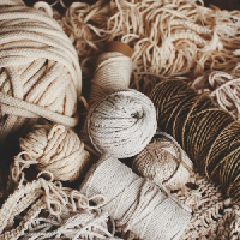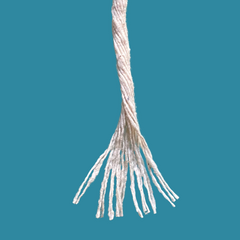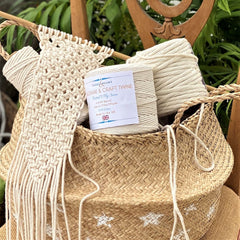Macramé Cord Guide - Which macramé cord should I use?
Being a beginner to macramé can be difficult; there are so many different names for the materials you can use: string, rope, cord, yarn, twine… So, we wanted to give a bit more information about the different cord that Tassel & Plume have available, to help you decide where to start.
We offer 2 different types of cord in different thicknesses. The one to use depends on the type of project, the size of the finished piece, and how much detail you want to include. To be honest, there isn’t a right or wrong cord to use, it’s just that some cords work better for certain types of projects.
Let’s start with the difference between single twist and 3 ply twist:
Single twist
This is a single group of many fibres that are twisted into one. It is very soft and flexible to work with, and the knots created can appear flatter than the 3-ply twist. It’s worth noting that if you are working on a project that is quite time consuming, you will find that over time the cord can start to untwist and expand, although it shouldn’t be very noticeable.
Single twist is ideal for creating straight fringes and feathers, as it can be combed without needing to untwist it first, unlike the 3-ply twist. It’s also great for more intricate designs.
Click Here to head over to our Single Twist Collection.
3-Ply Twist
This is made from 3 groups of twisted fibres, which are then twisted together, giving it a rope like appearance. The cord provides more structure, and holds its shape better when knotted, so the knots stand out more. The 3-ply twist offers added texture and wall hangings can appear thicker and chunkier.
The 3-ply twist cord is better when more strength is needed, such as for plant hangers, and when untwisted, can create a fabulous wavy fringe effect. Some users have found that it can add depth and detail to a wall hanging, where they have started off with the cord as one piece at the top, giving a chunkier effect, and then untwisted it further down to add more elaborate detail.
Click Here to head over to our Twisted 3 Ply Collection.
Hopefully that has helped with the difference between the single twist and 3-ply twist, so we’ll move on to:
Thickness
The thickness of the cord you use is, again, dependent on your type of project, the size, and the look you are going for. Thicker rope is better for larger designs, as you don’t need so many knots, making it less time consuming, but it does mean you might not get as much detail in your creation; it really depends on what you are looking to achieve.
1-2mm cord falls in to the small category, and is mostly used for jewellery or intricate pieces, so maybe not for a large wall hanging unless you have a lot of time on your hands!
3-5mm cord falls in to the medium category, and this is the thickness that most people tend to use for plant and wall hangings. Most people advise that the 5mm cord is best for beginners, as it is easier to work with, and doesn’t take so long to create the first few projects. After gaining some experience you can then move on to 3 or 4mm cord when you want to add more detail to your design.
6mm + cord falls into the large category and tends to be used for creations covering a large area of space – there are fewer knots, but they appear bigger.
Why not head over and read our other blog on Macrame Project Ideas for further inspiration and help on your next Macrame Idea.
If you are still unsure, why not try a few of the thicknesses in the different twists for various projects and see what you like best! Everyone is different, so what might be too chunky for some, might look perfect to you.
We hope this Macrame Cord Guide - Which macramé cord should I use? Blog has been helpful, but if you have any questions please contact us either through the contact page on our website, or send an email to info@tasselandplume.co.uk.








